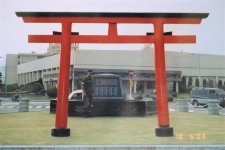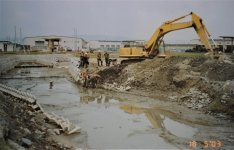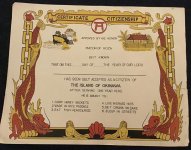OLDNAVYMCPO
US Veteran, Absent Comrade
When US forces came ashore on Okinawa, they found a determined Japanese force in desperate defense of their homeland. They were dug into a vast network of tunnels and caves. The US had found this to be the case on almost every island in the Pacific.
To the Japanese, the peoples of Okinawa were an inferior, almost sub-human race. The Japanese forced the civilians to serve them as slaves as they did on most conquered territories. Young women were forced to serve as pleasure slaves. Men were forced to serve in the army or as laborers in the construction of the cave/ tunnel networks. Those civilians with medical training were forced to serve in field hospitals.
As the course of the battle for Okinawa advanced, the Japs were reduced to living like rats in starving and unsanitary conditions in the caves. Not only did they suffer the wounds of battle but were victimized by the countless jungle diseases, parasites and infections so common in such an environment.
Under constant barrage by naval gunfire, napalm assault by carrier aircraft and attack by ground forces, the destruction of both civilian and Jap troops was astronomical.
Jap forces were overwhelmed by the medical cost of loss of trained medical personnel, lack of medicine and no resupply.
Refusing surrender, the Japs were desperate to provide some notion of medical care to the rapidly growing population of seriously wounded and sick troops.
As the battle for Okinawa progressed, 219 high school youths, mostly young girls and 18 teachers were ordered to serve as medical aids for the Japanese Field Hospital. They would care for the most hopeless and helpless cases.
Because of the relentless nature of the Jap defense, the American forces resorted to napalm, flamethrowers and Willy Peter, to drive the defenders from their caves.
The cave complex of the Field Hospital where the students were held was assaulted by US troops. As in every other case, the occupants were given a choice to surrender. Whether forced to remain or complicit, no one will ever know. The young girls, unbeknownst to American troops, were burned alive along with their captors.
The cave henceforth became known as the Cave of the Virgins.
Okinawa was the scene of some of the most vicious fighting of WWII. American losses there contributed to the decision to use the atomic bomb.
On my last tour of duty, I had to inspect Seabee construction on Okinawa as a part of my job. The first photo is me at the Memorial for Vietnam KIA. The second photo is of Seabees at work on a damaged drainage system. The third is me at the Jungle Warfare Center.
To the Japanese, the peoples of Okinawa were an inferior, almost sub-human race. The Japanese forced the civilians to serve them as slaves as they did on most conquered territories. Young women were forced to serve as pleasure slaves. Men were forced to serve in the army or as laborers in the construction of the cave/ tunnel networks. Those civilians with medical training were forced to serve in field hospitals.
As the course of the battle for Okinawa advanced, the Japs were reduced to living like rats in starving and unsanitary conditions in the caves. Not only did they suffer the wounds of battle but were victimized by the countless jungle diseases, parasites and infections so common in such an environment.
Under constant barrage by naval gunfire, napalm assault by carrier aircraft and attack by ground forces, the destruction of both civilian and Jap troops was astronomical.
Jap forces were overwhelmed by the medical cost of loss of trained medical personnel, lack of medicine and no resupply.
Refusing surrender, the Japs were desperate to provide some notion of medical care to the rapidly growing population of seriously wounded and sick troops.
As the battle for Okinawa progressed, 219 high school youths, mostly young girls and 18 teachers were ordered to serve as medical aids for the Japanese Field Hospital. They would care for the most hopeless and helpless cases.
Because of the relentless nature of the Jap defense, the American forces resorted to napalm, flamethrowers and Willy Peter, to drive the defenders from their caves.
The cave complex of the Field Hospital where the students were held was assaulted by US troops. As in every other case, the occupants were given a choice to surrender. Whether forced to remain or complicit, no one will ever know. The young girls, unbeknownst to American troops, were burned alive along with their captors.
The cave henceforth became known as the Cave of the Virgins.
Okinawa was the scene of some of the most vicious fighting of WWII. American losses there contributed to the decision to use the atomic bomb.
On my last tour of duty, I had to inspect Seabee construction on Okinawa as a part of my job. The first photo is me at the Memorial for Vietnam KIA. The second photo is of Seabees at work on a damaged drainage system. The third is me at the Jungle Warfare Center.





